Ancient Celtic warfare
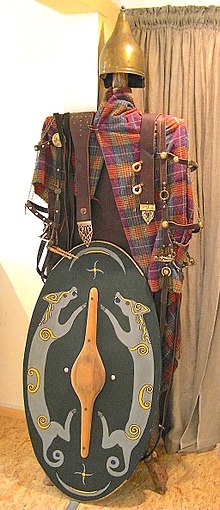
Ancient Celtic warfare refers to the historical methods of warfare employed by various Celtic people and tribes from Classical antiquity through the Migration period.
Unlike modern military systems, Celtic groups did not have a standardized regular military. Instead, their organization varied depending on clan groupings and social class within each tribe.
Endemic warfare was a common and significant aspect of life in Celtic societies. However, the organizational structures of these tribes differed widely. Some had rigid hierarchies with ruling monarchies, while others operated with representational structures resembling republics.
Over time, the expansionist policies of the Roman Empire led to the incorporation of many continental Celtic peoples into Roman rule, such as southern Britain. Resulting in the adoption of Roman culture by Gallic and Brittonic cultures. This led to the rise of hybrid cultures known as Gallo-Roman and Romano-British during Late antiquity. As a consequence, Celtic culture became predominantly confined to Insular Celtic people.
While archaeological discoveries offer valuable insights into the material culture of the Celts, determining the precise nature of their ancient combat techniques remains a topic of speculation.
| Part of a series on |
| War |
|---|
Mythological

This story describes combat centered on the use of the
Tribal warfare
Archaeology provides much information regarding the material culture of the Celts, especially that of the La Tène culture and Hallstatt culture. However, the significance of these finds in determining how the ancient Celts actually fought is the subject of much speculation and debate. It was long thought, for instance, that the Celts were headhunters, but recent research from France has indicated that it may have been the heads of slain allies that were collected to be placed in porticos, while the defeated were dumped in mass graves, their weapons ritually broken.[3]
Hallstatt cultures 1200 BC to 450 BC
The Hallstatt culture is the earliest to be identified as associated with Celtic culture, spreading from north of the Alps west into France, Southern Britain and the Iberian Peninsula. The earlier phases of the Hallstatt era fall into the Bronze Age. Swords seem to have been the primary weapon from this period, perhaps indicating that warfare was a relatively small scale affair, possibly between groups of elite warriors.

In the latter phases of the Hallstatt era, iron began to replace bronze in the manufacture of weapons, and the classic "

At the very end of the Hallstatt era, the longsword seemed to fall out of favor, ousted by shorter, thrusting daggers which are found in greater numbers among grave goods in high status burials.[5]
La Tène Culture 450 BC to 50 BC

The La Tène period saw changing patterns of warfare. At the beginning of the La Tène period warfare was likely conducted on a small scale between elite warriors, perhaps in chariots, wielding a new type of Celtic longsword.
During the succeeding centuries the design of the sword changed, characteristically becoming shorter, single-edged and lacking a thrusting point, designed purely to make a cut (although the Hallstatt era sword had also been primarily a slashing weapon).[6] and greater regional variation in swords appeared: in Britain and Ireland even the longer sword designs were shorter and thinner than their Continental counterparts.[7] It is possible that in the later La Tène era, an increasing population would have led to larger armies organized in ranks of spearmen, leading to a decline in the importance of the champion with his sword and hence a decline in sword functionality.
The La Tène era also saw the development of armor in the form of
Chariot burials continued well into the La Tène period, suggesting their continued importance in warfare. The La Tène chariot was a light, two-wheeled vehicle, unlike the heavier chariot of earlier times. The arrangement of the chariot poles in a reconstruction of the
In the Later La Tène period,
Continuation in Ireland
Roman conquest eventually extinguished the cultural and political independence of all the Celtic peoples starting on the Italian peninsula, then the Iberian Peninsula, Anatolia, Gaul and finally southern Britain. Celtic cultural independence survived only in Ireland, Scotland, Wales and Cumbria.
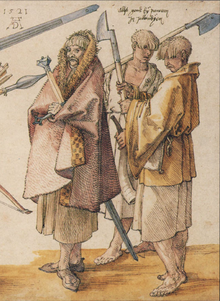
After the Roman era, only in the British Isles, therefore, could there be said to still exist a distinctly Celtic culture, peoples and style of warfare. Ireland was the last region to adopt the La Tène style of Celtic culture and technology with a smaller and less dense population than that of the British or Continental Celts, the Gaelic Irish sustained an era of small scale elite clan warfare for much longer.[9]
The
Gallic Wars

The best known Roman source for descriptions of Celtic warfare was from Julius Caesar in his Commentaries on the Gallic Wars in which he describes the methods of warfare of both the Gauls and the Britons.
The Gallic Wars were a series of military campaigns waged by the Roman proconsul against Gallic tribes, lasting from 58 BC to 51 BC. The Romans would also raid Britannia and Germania, but these expeditions never developed into full-scale invasions. The Gallic Wars culminated in the decisive Battle of Alesia in 52 BC, in which a complete Roman victory resulted in the expansion of the Roman Republic over the whole of Gaul. These wars paved the way for Caesar to become the sole ruler of the Roman Republic.
Descriptions of battles against various Gallic tribes, heavily contrasts the popular picture of the wild and naked Celtic warrior. Caesar even speaks of the
It is perhaps the descriptions of the
The other popular image of pre-Roman Britain, the scythed chariot, is not mentioned by Caesar either but alluded to by later commentators, such as Pomponius Mela, during and after the Roman conquest.
Celtic troop types and organization

No Celtic group employed a regular military as we would understand it. Organization was according to

The earliest Celtic encounter with
In 280 BC, a great army of
According to
Infantry and cavalry
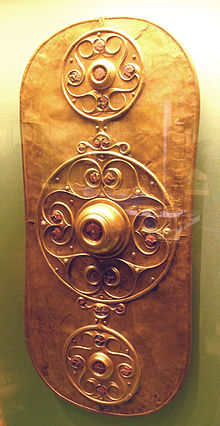
Celtic arms and armor were in fact highly advanced, as the Celts were renowned master Iron workers in the
Following the Celtic invasion of Greece in the 3rd century BC, the proliferation of elements of Celtic styles of weaponry and equipment had spread both far and wide, such as chain mail-style armor, the Montefortino, Coolus and Aden style helmets, thyreos-style body shields, and gladius and spatha style swords. Even though Celtic peoples had access to iron swords and armor, they were only available to a select few within Celtic society. Thus, aside from the King, Chief and wealthy nobility, body armor was rare, with most warriors wearing colorful cloaks or tunics, shirts, and pants, although some may have stripped to the waist or in some instances wore nothing at all into battle. The Celts’ main early advantage was their ability to scare and intimidate foes on the battlefield. Thus, even though most Celtic warriors were unarmored, the Celts themselves fought in the manner of heavy infantry, using fear and shock tactics as a form of psychological warfare while closing in on enemy formations in dense masses in order to break enemy lines and rout formations. This was an incredibly successful and effective tactic at first, such as at the Battle of the Allia.

Celtic peoples were also renowned for their skill as
The
In earlier encounters with the Romans, such as the Battle of Sentinum, some Celts would employ the chariot.[29] Although chariots had fallen out of use in continental Europe from the end of the 3rd century BC, Caesar found that they remained significant in Brittonic warfare. If his descriptions are to be believed, he encountered in Britain an army in transition, possessing cavalry but still with an elite fighting from chariots. He describes how these warriors would throw javelins from their vehicles before abandoning them to fight on foot and returning to them in order to retreat or redeploy.[30] Cavalry proper is described as used for skirmishing. Gauls are said to have commented that they themselves had formerly used chariots but had abandoned them by this time.
Their mode of fighting with their chariots is this: firstly, they drive about in all directions and throw their weapons and generally break the ranks of the enemy with the very dread of their horses and the noise of their wheels; and when they have worked themselves in between the troops of horse, leap from their chariots and engage on foot. The charioteers in the meantime withdraw a little distance from the battle, and so place themselves with the chariots that, if their masters are overpowered by the number of the enemy, they may have a ready retreat to their own troops. Thus they display in battle the speed of horse, [together with] the firmness of infantry.[31]
Mercenaries
Celtic warriors served as
The Greek historian Polybius gives an account of the Battle of Telamon 225 BC in which the Romans defeated an invasion by the Boii, Insubres, Taurisci and Gaesatae. The Gaesatae were said to be a group of warriors who fought for hire and it is they who are described in the most detail. Whereas the Boii and Insubres wore trousers and cloaks which were thick enough to afford limited protection from the Roman javelins, the Gaesatae removed their clothes to fight naked, standing in front of their allies and seeking to intimidate the Romans with shouting and gesturing. However, this lack of protection caused their defeat since they carried relatively small shields which did not adequately protect them against the missile fire of the Roman skirmishers. Suffering heavy casualties, the Gaesatae either fled the battlefield or desperately charged headlong into the Roman lines where, outmatched for both numbers and equipment, they were defeated. What position the Gaesatae occupied in Celtic society has been much debated. Early writers assumed that they were a tribe, but later authors have inclined to the view that they may have been groups of unattached young warriors who lived by raiding and mercenary activities like the early Roman iuventes or the semi-legendary Irish fianna.[33]
There are accounts of Celtic soldiers working as mercenaries for many of the great dynasties of the

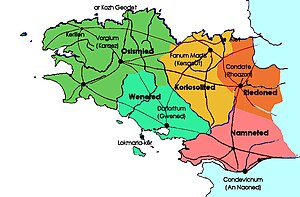
While relatively little has been written about Celtic warfare at sea, the Gallic Veneti, a tribe dwelling on the southern coast of Armorica (Brittany), along the Gulf of Morbihan, was well known and renowned among the Gauls as a strong seafaring people .
The Veneti had trading stations in
Following the beginning of the
At first the Roman galleys, fighting in unfamiliar conditions, were at a great disadvantage and suffered defeats and setbacks. Julius Caesar gave Decimus Junius Brutus Albinus command of the Roman fleet and the Roman navy adopted new tactics in order to quell the activities of the Veneti once and for all. Instead of boarding or capturing ships, the Romans would simply set them on fire. The Roman fleet under Albinus subjected the Veneti to savage reprisals for their earlier defiance. This culminated in the Battle of Morbihan when the Romans succeeded in setting aflame and destroying the entire Gallic fleet in Quiberon Bay, with Caesar watching from the shore. Following this defeat, their maritime commerce and trade activities declined under the Roman Empire.[36]
Fortifications

Large stores of slingstones aerodynamically shaped by adding clay have been found in the Southern British hillfort of Maiden Castle[37] which indicates that slings must also have played a role in the conflicts between Celtic tribes there, probably in sieges.

The
The
This section needs expansion. You can help by adding to it. (September 2009) |
External influence

Celts were influenced by other peoples but they heavily influenced the warfare of their enemies.
Germanic Cultures
Celtic influence on
Close to the Rhine, in the region of Westphalia and Lower Saxony, multiple La Tène spearheads have been identified in local context at Borchen-Gellinghausen,[49] Olfen-Kökelsum[50] and Schnippenburg, and two La Tène swords at Wilzenberger.[51] Schnippenburg's site is an interesting case of Middle La Tène influence on several aspect of the local lifestyle (fortification, adornment, weaponry, cult). Quoting Sebastian Möllers: "Until 10 to 15 years ago, there was still the assumption that the La Tène culture was largely confined to the described core space. However, the results of recent research paint a whole new picture. And especially in this context, the findings of the Schnippenburg is a very special place."[52]
The Przeworsk culture is a culture beginning at the 2nd century BC; it is characterized by a cultural facies strongly influenced by the La Tène culture.[53][54][55] Compared to Elbe cultural groups, the Przeworsk culture is best documented regarding weaponry prior to the period of the Roman Empire, as cremation graves are frequently accompanied by weapons. It is generally interpreted as warlike society.[56] On the matter, Celtic iron chain belts, iron scabbards, spurs, knives and fibula are found in the graves.[53][57][58][59] In contrast to the scabbards found in other Germanic regions, Przeworsk culture seems to have adopted the characteristic suspension of Middle La Tène swords during the first half of the 2nd century BC.[60] Although single edged swords commonly related to Germanic cultures are also common in warrior graves. A sword with a bronze pseudo-anthropomorphic hilt elements typical of the Middle La Tène has been discovered in the Vistula River close to the village of Siarzewo (Poland).[61]
Thracians
The Celts influenced Thracian warfare in the adoption of certain long swords by the Triballi, for example, although this was not universal among the Thracians. Another weapon, the sica, was called the Thracian sword[62] (Ancient Greek: Θρᾳκικὸν ξίφος) though it did not originate there, despite its popular usage.[63] Considered Thrace's national weapon, the sword's ultimate origin was the Hallstatt culture[64] and the Thracians may have or adopted or inherited it.
Dacians
Several archaeological discoveries suggest an important influence on the
Illyrians
Greeks
Following the
Romans

The
Celts depicted as barbarians
From their earliest interactions, the major civilizations of Classical antiquity such as Greek, Roman, Etruscan and Macedonian civilizations faced major threats from the Celtic world. Early in the period, the Etruscans had to deal with the Celtic Biturges' mass migration crossing the Alps under the lead of Bellovesus in the 5th century BC. The Romans' first major encounter with the Celts, at the Battle of the Allia, was an outright disaster for the fledgling Roman Republic. The inexperienced Roman army was routed; this defeat culminated with the Senones, led by their war leader, Brennus, sacking the city except for the Capitoline Hill. Even though the Romans were able to save their city and wrest control back, these events left a lasting impression on the Roman people.

The Greeks and Macedonians had their own issues with the Gallic tribes. Celts originating from various La Tène chiefdoms and Noricum began a mass migration and settlement of the Balkans from the 4th century BC. These expeditions were led by multiple leaders, including another Brennus, Acichorious, Bolgios, Cerethrius and Leonnorius. These migrations had a massive impact on the region and culminated with a series of events: the defeat and decapitation of the Macedonian king, Ptolemy Ceraunus, the defeat of a Greek Army at the Battle of Thermopolaye, the subsequent attack on Delphi and finally the foundations of the settlement in Asia Minor that became home to the Galatians. This series of events left a lasting impression on the Greeks.
Later, the military position was reversed as the
One of the practices of the Celts that the Greco-Roman civilizations found especially barbaric was
Ancient Romans and Greeks recorded the Celts' habits of embalming in
Both the Greeks and Romans found the Celtic decapitation practices shocking, and the Romans made sure to put an end to them when Celtic regions came under their control. However, Greeks and Romans both employed decapitation and other horrific tortures, highlighting a tendency to view practices as more shocking when carried out by an outside group, even if the practices were essentially similar.[87]
In the 5th century BC, Greek writer
The Celts were described by classical writers such as
Celtic war leaders




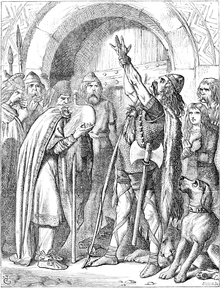
- Acco of the Gallic Senones
- Gallic invasion of the Balkans
- Ambiorix of the Belgic Eburones
- Aneroëstes of the Gallic Gaesatae
- Arthur of the Celtic Britons
- Autaritus of the Gallic Mercenary Army
- Bellovesus of the Gallic Bituriges
- Averni
- Boduognatus of the Belgic Nervii
- Boiorix of the Cimbri
- Gallic invasion of the Balkans
- Boudica of the Brittonic Iceni
- Gallic invasion of the Balkans
- Britomaris of the Gallic Senones
- Caesarus of the Iberian Lusitanians
- Camulogene of the Gallic Aulerci
- Calgacus of the Brittonic Caledonians
- Caratacus of the Brittonic Catuvellauni
- Cartimandua of the Brittonic Brigantes
- Carvilius of the Brittonic Cantiaci
- Cassivellaunus of the Brittonic Catuvellauni
- Castus of the Gladiator War
- Catigern of the Celtic Britons
- Cativolcus of the Belgic Eburones
- Gallic invasion of the Balkans
- Cingetorix of the Brittonic Cantiaci
- Commius of the Belgic Atrebates
- Concolitanus of the Gallic Gaesatae
- Corocotta of the Iberian Cantabri
- Crixus of the Gladiator War
- Divico of the Helvetian Tigurini
- Ducarius of the Gallic Insubres
- Dumnorix of the Gallic Aedui
- Erispoe of the Brittonic Bretons
- Galba of the Belgic Suessiones
- Gannicus of the Gladiator War
- Gausón of the Iberian Astures
- Indutiomarus of the Gallic Treveri
- Julius Classicus of the Gallic Treveri
- Julius Indus of the Gallic Treveri
- Larus of the Iberian Cantabri
- Gallic invasion of the Balkans
- Lucterius of the Gallic Cadurci
- Nominoe of the Brittonic Bretons
- Welsh Revolt
- Oenomaus of the Gladiator War
- Olyndicus of the Iberian Celtiberians
- Riothamus of Brittonic Dumnonia
- Segovax of the Brittonic Cantiaci
- Segovesus of the Gallic Bituriges
- Punicus of the Iberian Lusitanians
- Tanginus of the Iberian Celtiberians
- Tautalus of the Iberian Lusitanians
- Taximagulus of the Brittonic Cantiaci
- Togodumnus of the Brittonic Catuvellauni
- Venutius of the Brittonic Brigantes
- Vercingetorix of the Gallic Arverni
- Viriathus of the Iberian Lusitanians
- Viriathus of the Iberian Gallaeci
- Viridomarus of the Gallic Insubres
- Viridovix of the Gallic Venelli
- Vortigern of the Celtic Britons
- Vortimer of the Celtic Britons
List of Celtic conflicts and battles
This is a list of battles or conflicts in which
BCE
- 390: Battle of the Allia
- 390: Sack of Rome
- 361: Battle of the Anio River
- 358: Battle of Pedum
- 295: Battle of Sentinum
- 284: Battle of Arretium
- 283: Battle of Lake Vadimo
- 279: Invasion of Greece
- 279: Battle of Thermopylae
- 279: Attack on Delphi
- 277: Battle of Lysimachia
- 241: Battle of the Caecus River
- 241: Mercenary War
- 240: Defection of Naravas
- 238: Battle of Aphrodisium
- 225: Battle of Faesulae
- 225: Battle of Telamon
- 222: Battle of Clastidium
- 218: Battle of Rhone Crossing
- 218: Battle of the Trebia
- 217: Battle of Lake Trasimene
- 216: Battle of Silva Litana
- 216: Battle of Cannae
- 200: Battle of Cremona
- 194: Battle of Placentia
- 193: Battle of Mutina
- 189: Battle of Mount Olympus
- 189: Battle of Ancyra
- 181: Siege of Aebura (Carpetania)
- 181: First Celtiberian Rebellion
- 181: Battle of Manlian Pass
- 155: Lusitanian War
- 154: Second Celtiberian War
- 154: Numantine War
- 152: Second Lusitanian Raid
- 148: Third Lusitanian Raid
- 134: Siege of Numantia
- 121: Battle of the Isère River
- 121: Battle of Vindalium
- 113: Battle of Noreia
- 107: Battle of Burdigala
- 105: Battle of Arausio
- 102: Battle of Tridentum
- 102: Battle of Aquae Sextiae
- 101: Battle of Vercellae
- 73: Gladiator War
- 63: Battle of Magetobriga
- 58: Battle of the Arar
- 58: Battle of Vosges
- 58: Battle of Bibracte
- 57: Battle of the Axona
- 57: Battle of the Sabis
- 57: Siege of the Atuatuci
- 57: Battle of Octodurus
- 55: Caesar's invasions of Britain
- 54: Ambiorix's revolt
- 53: Battle of Carrhae
- 52: Siege of Avaricum
- 52: Battle of Gergovia
- 52: Battle of Lutetia
- 52: Battle of Alesia
- 51: Siege of Uxellodunum
- 51: Battle of Morbihan
- 29: Cantabrian Wars
CE
- 43: Claudian invasion of Britain
- 43: Battle of the Medway
- 43: Capture of Camulodunum
- 50: Caratacus' last battle
- 60: Roman conquest of Anglesey
- 60: Boudican revolt
- 60: Battle of Camulodunum
- 61: Defeat of Boudica
- 83: Battle of Mons Graupius
- 140: Siege of Burnswark
- 208: Roman invasion of Caledonia
- 367: The Great Conspiracy
- 398: Stilicho's Pictish War
- 440: Battle of Guoloph
- 446: Groans of the Britons
- 455: Battle of Aylesford
- 457: Battle of Crecganford
- 460: Treachery of the Long Knives
- 466: Battle of Wippedesfleot
- 485: Battle of Mercredesburne
- 497: Battle of Badon
- 556: Battle of Beran Byrig
- 577: Battle of Deorham
- 580: Battle of Alclud Ford
- 592: Battle of Woden's Burg
- 596: Battle of Raith
- 600: Battle of Catraeth
- 603: Battle of Degsastan
- 611: Battle of Chester
- 628: Battle of Cirencester
- 630: Battle of Cefn Digoll
- 631: Battle of Heavenfield
- 633: Battle of Hatfield Chase
- 641: Battle of Maserfield
- 650: Siege of Exeter
- 660: Battle of Peonnum
- 671: Battle of Two Rivers
- 685: Battle of Dun Nechtain
- 720: Battle of Hehil
- 750: Battle of Catohic
- 760: Battle of Hereford
- 834: Battle of Blain
- 838: Battle of Hingston Down
- 845: Battle of Ballon
- 851: Battle of Jengland
See also
- Celts
- Celts in Transylvania
- Ancient warfare
- Roman–Gallic wars
- Gallic Invasion of the Balkans
- Galatian War
- Celtiberian Wars
- Cantabrian Wars
- Gallic Wars
- Dacian warfare
- Gaelic warfare
- Germanic warfare
- Illyrian warfare
- Thracian warfare
- Trimarcisia
- Warfare in the ancient Iberian peninsula
- List of ancient Celtic peoples and tribes
References
- ISBN 0-521-02014-X
- ^ Malleson, G.B. (1889). "Vercingetorix". Transactions of the Royal Historical Society. 4: 1–40. doi:10.2307/3678158. JSTOR 3678158.
- ^ "Grands Sites Archéologiques".
- ^ British Archaeology 76 "Ridding (sic) Into History"
- ISBN 0-415-34779-3,
- ^ Cowen, J. D., The Hallstatt Sword of Bronze: on the Continent and in. Britain, in: Proc. Prehist. Soc. 33
- ^ Piggott, S. (1950) 'Swords and scabbards of the British Early Iron Age', Proc. Prehist. Soc. 16
- ^ Building an Iron Age Chariot, Mike Loades http://www.mikeloades.co.uk/cms/images/British_Chariot.pdf
- ^ Ó Cléirigh, Cormac (1997). Irish frontier warfare: a fifteenth-century case study (PDF). Archived from the original (PDF) on 30 December 2010.
- ^ a b The Archaeology of Late Celtic Britain and Ireland c.400-1200AD, Lloyd Laing, 1975
- ^ Ashton, Kasey. "The Celts Themselves." University of North Carolina. Accessed 5 November 2017.
- ^ a b Caesar De Bello Gallica, Book 1, XXIV
- ^ Caesar De Bello Gallica, Book 7, XLI
- ^ Caesar De Bello Gallica, Book 5, XLIV
- ^ "The Problem of the Woad".
- ^ Plutarch, Camillus 15-30
- ISBN 978-2-13-060668-0.
- OCLC 36085150.
- JSTOR 286174.
- JSTOR 2543177.
- doi:10.17658/issn.2058-5462/issue-20/wschupbach/figure11 http://dx.doi.org/10.17658/issn.2058-5462/issue-20/wschupbach/figure11. Retrieved 2022-08-05.)
{{cite journal}}: Cite journal requires|journal=(help); Missing or empty|title=(help - ^ Grant, R. (2008). Warfare in the Ancient World. In Battle (pp. 32-33). DK Publishing.
- ^ Grant, R. (2008). Warfare in the Ancient World. In Battle (pp. 32–33). DK Publishing
- ISBN 1841761435, page 45
- ^ Polybius, The Histories, Book 2
- ^ The Geography of Strabo, § 4.4.2. ed. and trans. H. C. Hamilton and W. Falconer. London: George Bell & Sons, 1903.
- ^ Pausanias (1918). "10.19.10-11". Description of Greece in 4 volumes. W. H. S. Jones, H. A. Ormerod (translators). Cambridge, MA, London: Harvard University Press, William Heinemann Ltd. Available online at the Perseus Project.
- ^ Polybius Histories Book 2, 29–31
- ISBN 1841761435, page 47
- ^ Caesar, De Bello Gallica Book 4, XXXIII
- ^ The Gallic Wars, Chapter 33
- ISBN 1841761435, page 14
- ^ Mountain, H. The Celtic Encyclopedia (1998)
- ^ Rocca, Samuel (2009). The Army of Herod the Great. Osprey Publishing. pp. 15–16. ISBN 978-1-8460-3206-6. Retrieved 2 November 2013.
- ^ Levick, Barbara (2009). "The Veneti Revisited: C.E. Stevens and the tradition on Caesar the propagandist". In Welch, Kathryn; Powell, Anton (eds.). Julius Caesar as Artful Reporter: The War Commentaries as Political Instruments. Classical Press of Wales. ISBN 978-1-910589-36-6.
- ^ Drinkwater, John F. (2016). "Veneti (1), Gallic tribe". Oxford Research Encyclopedia of Classics.
- ISBN 978-0-415-34779-2
- ^ The Iron Age, smr.herefordshire.gov.uk
- ^ )
- OCLC 840391241.
- )
- ISSN 0035-2624.
- ^ Martens, Jes (January 2011). "Weapons, Armament and Society. The Pre-Roman Iron Age on Zealand and in Scania". The Iron Age on Zealand. Status and Perspectives.
- ^ Luczkiewcz, Piotr; Łuczkiewicz, Piotr. "Kriegergemeinschaften im Ostseebereich während der jüngeren vorrömischen Eisenzeit".
{{cite journal}}: Cite journal requires|journal=(help) - OCLC 35141354.
- ^ "Gräberfeld von Großromstedt", Wikipedia (in German), 2020-10-27, retrieved 2020-11-28
- ISBN 978-3-11-020280-9.
- ^ Meyer, Michael (January 2005). "Migration und Adaption. Ein differenziertes Modell zur Erklärung der latènezeitlichen Przeworsk Funde in Deutschland". Alt-Thüringen. 38.
- ISSN 2191-1207.
- ISSN 2191-1207.
- ^ Lehmann, Ulrich (2013). "Neues zu den ältesten Eisenschwertern aus Westfalen". Archäologie in Westfalen-Lippe.
- ^ "Die Schnippenburg im Fokus der Archäologie". Archäologie Online (in German). 2 July 2007. Retrieved 2020-11-28.
- ^ .
- ^ Bochnak, Tomasz. "Un nouveau regard sur la laténisation du bassin de la Vistule". Il Mondo Celtico Prima e Dopo la Conquista Romana.
- ^ Andrzejowski, Jacek (2010). U. Lund Hansen; A. Bitner-Wróblewska (eds.). The Przeworsk Culture. A Brief Story (for the Foreigners) Worlds Apart? Contacts across the Baltic Sea in the Iron Age. København-Warszawa: Nordiske Fortidsminder.
- S2CID 216735181.
- ISSN 1453-6943.
- ^ Maciałowicz, Andrzej. "With gold and sword. Contacts of Celts and early Germanics in central Europe. The historical background: 3rd - 1st c. BC".
{{cite journal}}: Cite journal requires|journal=(help) - ^ Bochnak, Tomasz; Harasim, Przemysław. "Reparierte Waffen der vorrömischen Eisenzeit in der Przeworsk- und Oksywie-Kultur, Archäologisches Korrespondenzblatt Jahrgang 45 · 2015 · Heft 4".
{{cite journal}}: Cite journal requires|journal=(help) - ISSN 1453-6943.
- S2CID 213474005. Retrieved 2020-11-26.
- ISBN 0-19-815047-4, 1998, page 203,""
- ISBN 0-517-48776-4, 1986
- ^ HaA(1200-1000), HaB(1000-800)
- ^ OCLC 1117739328.)
{{cite book}}: CS1 maint: others (link - ISSN 0076-5147.
- S2CID 166075687.
- ^ "Category:Dacian tomb of Cugir - Wikimedia Commons". commons.wikimedia.org. Retrieved 2020-11-26.
- ^ "Dacian settlements and necropolises in Southwestern Romania (2nd c. B.C.-1st c. A.D.)". arheologie.ulbsibiu.ro. Retrieved 2020-11-26.
- OCLC 1042957385.)
{{cite book}}: CS1 maint: location missing publisher (link - ^ Rustoiu, Aurel. "Aurel Rustoiu, Masters of metals in the Carpathian Basin (workshops, production centres and funerary manifestations in the early and middle La Tene)".
{{cite journal}}: Cite journal requires|journal=(help) - ISBN 0850454735, 1982, page 35
- ^ "Kingdoms of the Germanic Tribes - Bastarnae / Peucini". www.historyfiles.co.uk. Retrieved 2020-11-26.
- ^ Dacia: Land of Transylvania, Cornerstone of Ancient Eastern Europe by Ion Grumeza, 2009, page 88
- ^ Strab. 7.5,"they often used the Scordisci as allies"
- ISBN 0-19-510233-9, 1995, page 202,"contact with the peoples of the Illyrian kingdom and at the Celticized tribes of the Delmatae"
- ^ The Oxford Classical Dictionary, Simon Hornblower and Antony Spawforth, 2003, p. 1106
- ^ Encyclopedic Dictionary of Archaeology by Barbara Ann Kipfer, 2000, page 251,"... Sea and from there eastward to the Sar Mountains. The Illyrians, descendants of the hallstatt culture, were divided into tribes, each a self-governing community with ...
- doi:10.1400/210935.
- ^ Lejars, Thierry (2008), Verger, Daniele Vitali e Stéphane (ed.), "Les guerriers et l'armement celto-italique de la nécropole de Monte Bibele", Tra mondo celtico e mondo italico: la necropoli di Monte Bibele: atti della tavola rotonda, Bologna: Università di Bologna, Dipartimento di archeologia, pp. 127–222, retrieved 2020-11-26
- )
- ^ Tondo, Manuela (January 2012). "Nicosia-Tondo-Sacco 2012_Ricerche archeologiche e topografiche nel Comune di San Vittore del Lazio (Frosinone) in Lazio e Sabina 8".
{{cite journal}}: Cite journal requires|journal=(help) - )
- JSTOR 26364279.
- ISBN 1841761435, page 3
- OCLC 51779742.
- ISBN 978-0-19-953940-6.
- ^ Aristot. Eud. Eth. 3.1229b
- ISBN 1841761435, page 15
- ^ Dionysius of Halicarnassus, Roman Antiquities p259 Excerpts from Book XIV
- ISBN 1841761435
External links
- "Ancient Celtic Warfare". Archived from the original on February 27, 2012.
{{cite web}}: CS1 maint: unfit URL (link) - Celtic Warriors
- Ancient Celtic Warriors in History
- Ross Cowan, Gladius Gallicus: Celtic Swords for Italic Warriors
- Ross Cowan, Etruscan and Gallic (Celtic) heavy javelins

